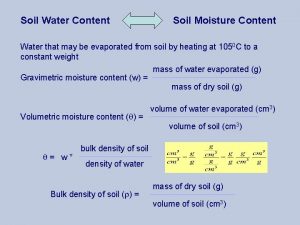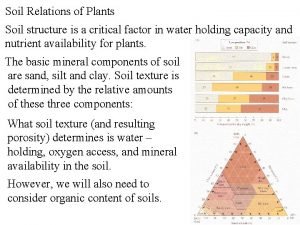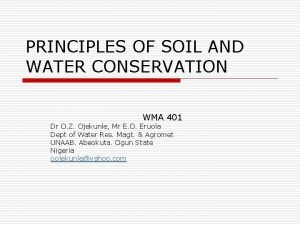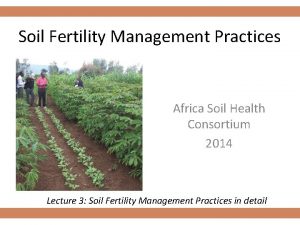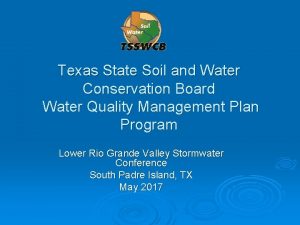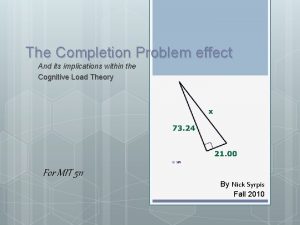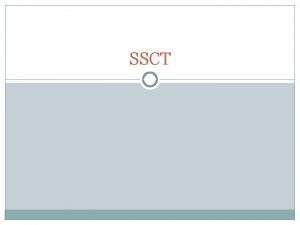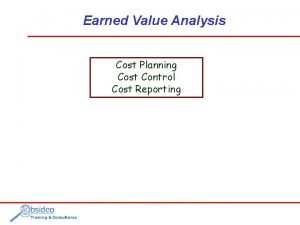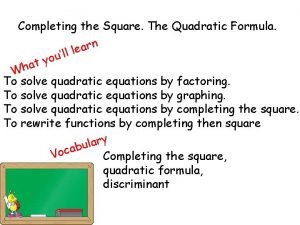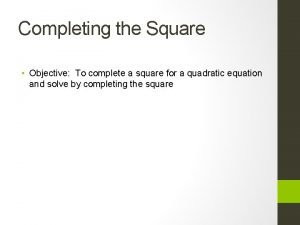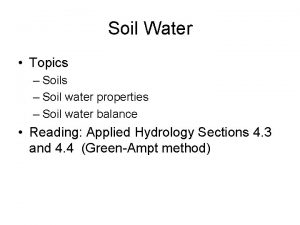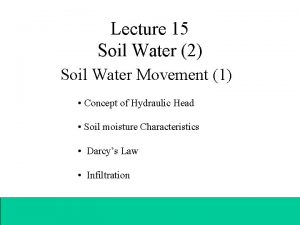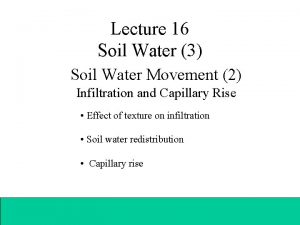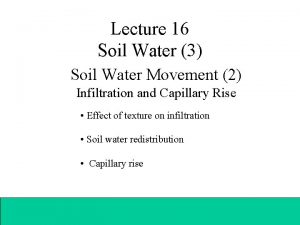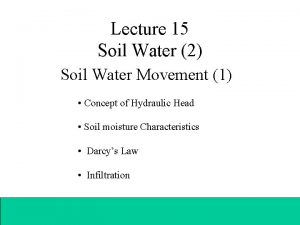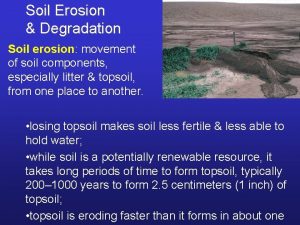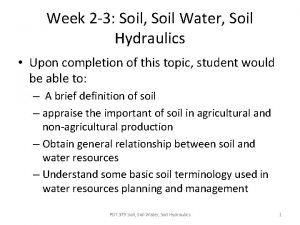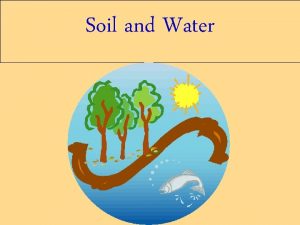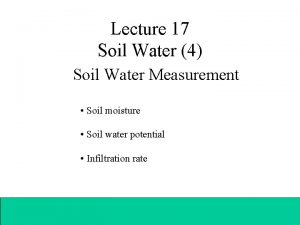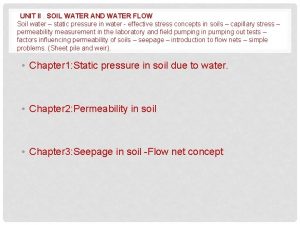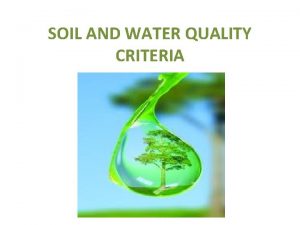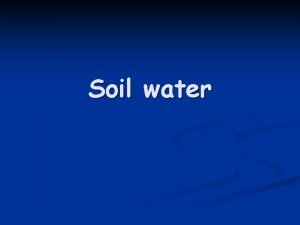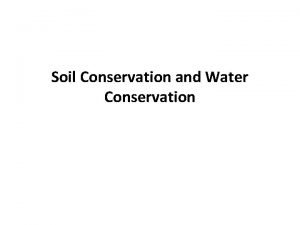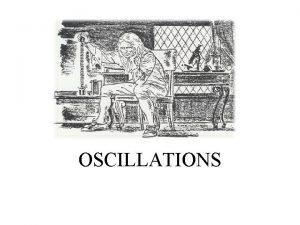Soil Water Movement Upon completion of this topic











































- Slides: 43

Soil Water Movement • Upon completion of this topic, student would be able to: – Understanding the various type of water potential exist in the soil – Basic principle and governing equation of soil water movement, Darcy’s Law – Quantify the soil water movement vertically and laterally within the soil profile PDT 379 Soil Water Movement 1

Water Potential, ψw • A soil property needs to be defined to predict soil water flow (movement) since water content alone is not sufficient • Understanding the water potential at each particular point within the soil profile would help us to indicate the direction water flow within the soil body • Water potential is formally defined as the amount of work that a unit quantity of water in an equilibrium soil-water (or plant-water) system is capable of doing when it moves to a pool of water in the reference state at the same temperature • The reference state commonly chosen is pure free water PDT 379 Soil Water Movement 2

PDT 379 Soil Water Movement 3

PDT 379 Soil Water Movement 4

PDT 379 Soil Water Movement 5

Water potential, ψw • Water potential, ψw= ψm + ψs + ψp – Ψm = matric potential of the soil depending on soil moisture – Ψs = solute potential due to chemical concentration difference – Ψp =pressure potential due to pressure diff to the free water surface • Total Water Potential, Ψt = ψw + ψz – Ψz = gravitational potential due to elevation difference • Unit – Mass of water = joules/kg – Pressure of water = Pascal, Pa – Weight of water = meter or mm PDT 379 Soil Water Movement 6

PDT 379 Soil Water Movement 7

PDT 379 Soil Water Movement 8

PDT 379 Soil Water Movement 9

PDT 379 Soil Water Movement 10

PDT 379 Soil Water Movement 11

PDT 379 Soil Water Movement 12

Law of Soil Water Flow • 1 st Law: Water flows from high to low potential – (+ve) pressure (>0 atm) – (-ve) negative pressure (suction) (<0 atm) • These potentials are used to determine the direction of water flow (x, y, z) and the amount of flow (Q) PDT 379 Soil Water Movement 14

Gravitational potential, ψz • Vertical distance from any arbitrary reference elevation to the point of interest • Ψz is (+ve) if the point of (+ve) interest is above reference (-ve) • Ψz is (–ve) if the point of interest is below reference • Ψz is independent of soil properties PDT 379 Soil Water Movement Reference Soil Column 15

Eg 1: Gravitational potential, Ψz • Given – Two points in a soil, A & B – Each point is located a specified distance above a reference elevation, X – Point A is 150 mm above the reference – Point B is 100 mm below the reference A 150 mm X • Find reference 100 mm – The difference in gravitational potential, ψz between 2 points – Show your working steps PDT 379 Soil Water Movement B 16

Eg 2: Ψz • Given – The same two points as specified in eg 1 but the reference elevation is 50 mm below point A A 50 mm reference • Find – The difference in gravitational potential, ψz , between the two points PDT 379 Soil Water Movement 200 mm B 17

Matric Potential, Ψm • Defined as the vertical distance between a point (Point A) in the soil and water level of a manometer connected to this point • Manometer is a device use to measure the soil pressure (+ve pressure) or soil suction ( -ve pressure) • If the manometer water level is below the porous cup, Ψm is (-ve) pressure or suction (unsaturated soil) • The highest value possible for Ψm is 0, i. e. soil under saturated condition • Recalled, the FC of soil is at Ψm = - 300 mm (30 k. Pa). The PWP of soil is at Ψm =150, 000 mm (1500 k. Pa) • From the above definition, the Ψm of the soil in Fig is (–ve) 150 mm PDT 379 Soil Water Movement Porous Cup A 150 mm 18

Tensiometer, Ψm • The tensiometer is an instrument that is used to measure the Ψm of soil, but within the range of one atm (100 cm or 100 k. Pa) PDT 379 Soil Water Movement 19

Piezometer, Pressure potential, Ψp • Ψp is the vertical distance from a point in question to the free water surface (water table elevation) • Also known as “submerged” potential or “overburden” pressure • Piezometer, a tube open to the atm that passes through the point of interest is commonly use to measure Ψp PDT 379 Soil Water Movement Water Table (0 atm) 100 mm Piezometer 20

Ψs Solute Potential • Potential due to solute concentration difference between the point of interest • Eg: 2 point of interestbetween point at soil and point at plant root • Always negligible for a small volume of soil under equilibrium (static) condition PDT 379 Soil Water Movement 21

Water potentials for Equilibrium Conditions • An equilibrium condition of soil water occur when no plants are involved and or solute concentrations of the soil solution are negligible • Under such condition, the combination of Ψm Ψz Ψp known as Ψh (hydraulic potential). Ψh = Ψm + Ψp + Ψz • Knowing the Ψh at two different points, under an equilibrium condition, the magnitude of soil water flow can be quantified PDT 379 Soil Water Movement 22

Eg#1. Ψh equilibrium • Given – A soil in which the water is in equilibrium with water table at ( -ve) 700 mm (Point B) and the reference level is chosen as (ve 700 mm • Find – The values of Ψp Ψm Ψz Ψh throughout the soil profile to (ve) 1100 mm (Point C) – Assume the Ψm PDT 379 Soil Water Movement 0 mm A Soil Profile -700 mm reference level B -1100 mm C 23

Eg#2. Ψh equilibrium • Repeat Eg#1 on Ψh equilibrium except the reference level is the soil surface (Point A). • Find Ψp Ψm Ψz Ψh throughout the soil profile to -1100 mm • Assume Ψm 0 mm Soil Profile -700 mm Water Table -1100 mm PDT 379 Soil Water Movement reference level A B 24

Water potential for non-equilibrium conditions • Equilibrium conditions for water flow in soil are rarely found because the soil water flow varies with other variables such as soil moisture, water uptakes by the plant’s root, nutrient (solute) difference, water table dynamics etc. • Thus, the soil water flow always occur under nonequilibrium condition • The principle of water potential Ψh = Ψm +Ψz +Ψp still applies at least for flow direction PDT 379 Soil Water Movement 25

Eg#1. Water potential for nonequilibrium Evaporation • Given: – Water is evaporating at the soil surface and there is a water table at -0. 4 m. The reference level is at the soil surface. 0 mm • Find: – Values of Ψh Ψm Ψz Ψp throughout of the soil profile to -0. 6 m – Draw the water potential diagram – Make estimate of the value of Ψm – In this problem, what makes nonequilibrium occurs? PDT 379 Soil Water Movement -0. 4 m Water Table -0. 6 m 26

Eg#2. Water potential for nonequilibrium • Given: – A soil in which water is flowing into a drain at 400 mm. The reference level is the soil surface • Find: – Values of Ψh Ψm Ψz Ψp for the entire soil profile to -600 mm – Estimate must be made for Ψm – Draw the water potential diagram – In this problem, what makes non-equilibrium occurs? Reference line -400 mm -600 mm PDT 379 Soil Water Movement 27

Eg#3. Water potential for nonequilibrium • Given: – A soil was initially quite dry. It received rain that wet the soil from the surface downward through the soil profile. After a few days, the surface had dried and water moved upward in response to the evaporation. At lower depths, however, the soil water moved downward into the soil that had not been wetted by the rain. The reference level is at the soil surface E P 0 m • Find: – Values of Ψh Ψz Ψp throughout the soil profile to -0. 6 m using your estimate for Ψm – Draw the potential diagram – What make the soil-water system fall under non-equilibrium condition PDT 379 Soil Water Movement -0. 6 m 28

Measuring Ψm in the Lab • Using soil moisture chamber or soil moisture extractor to produce soil moisture characteristic curve • Soil moisture characteristic curve is a plot on the relationship between soil moisture and soil negative pressure (suction) or soil matric potential PDT 379 Soil Water Movement 29

Soil Water Characteristic Curve Ψm PDT 379 Soil Water Movement 30

BREAK PDT 379 Soil Water Movement 31

Water Flow in Soil • Upon understanding the basic principle of soil water and hydraulic potential, the magnitude (amount & direction) of water flow between 2 points can be quantified • Applying Darcy Law, introducing the concept of hydraulics gradient (not just hydraulic potential difference) PDT 379 Soil Water Movement 32

Darcy’s Law (Henry Darcy-1856) h 1 -h 2 1 h 2 2 A Q Q L 1. Q α (h 1 -h 2 ) 2. Q α 1/L 3. Q α A (Cross-sectional area) PDT 379 Soil Water Movement 33

Darcy’s Law • PDT 379 Soil Water Movement 34

Hydraulic Conductivity of soil, K • PDT 379 Soil Water Movement 35

K determination- Lab method • Name of device: Permeameter • 2 types of permeameter – Constant head permeameter • Suitable for non-cohesive and highly porous soil such as sand, peat, gravel – Falling head permeameter • Suitable for cohesive and slow porous soil such as clay, silty-clay PDT 379 Soil Water Movement 36

Constant Head Permeameter • A chamber with an overflow provides a supply of water at a constant head ( H) • Water moves through the sample at a steady state • The K is determined from a Darcy’s Law, which gives V the flow per unit time, Q • If we collect the total volume over the time t, the total volume of water V=Q*t PDT 379 Soil Water Movement Q 37

Constant Head Permeameter • PDT 379 Soil Water Movement 38

Falling head permeameter • A volume of water moves thru the sample • The initial water level above the outlet in the falling head tube, Ho is noted • After time t, the water level, H 1, is again measured PDT 379 Soil Water Movement 39

Falling head permeameter • PDT 379 Soil Water Movement 40

Falling head permeameter • PDT 379 Soil Water Movement 41

Eg. Darcy Law, K • Given: – Ψm (A) = -300 mm – Ψm (B) = -100 mm – K for soil column = 50 mm/day horizontal -550 mm -50 mm A • Find: – The water flux density, q, if the column is -550 mm vertical, sloped and horizontal A 300 mm -550 mm B Vertical PDT 379 Soil Water Movement B Slope 42

Eg. Constant Head Permeameter • A constant head permeameter has a sample of medium-grained sand 15 cm in length and 25 cm 2 in cross-sectional area. With head of 5. 0 cm, a total of 100 cm 3 of water is collected in 12 min. find the K PDT 379 Soil Water Movement 43

Eg. Falling Head Permeameter • A falling head permeameter containing a silty, fine sand has a falling head tube diameter of 2. 0 cm, a sample diamater of 10 cm, and a flow length of 15 cm. The initial head is 5. 0 cm. It falls to 0. 50 cm over a period of 528 min. Find the hydraulic conductivity PDT 379 Soil Water Movement 44
 Water and water and water water
Water and water and water water Living soil vs dead soil
Living soil vs dead soil Convergent plate boundaries
Convergent plate boundaries Infiltration capacity of soil depends upon *
Infiltration capacity of soil depends upon * General subject example
General subject example Narrow
Narrow Non movement area
Non movement area Swing axial movement
Swing axial movement What is the importance of soil
What is the importance of soil Water retention in soil
Water retention in soil Soil texture water holding capacity
Soil texture water holding capacity Water content of soil
Water content of soil Soil texture water holding capacity
Soil texture water holding capacity An ecosystem in which water either covers the soil
An ecosystem in which water either covers the soil Soil and water relationship
Soil and water relationship Environment vs ecology
Environment vs ecology Water conservation objectives
Water conservation objectives A tiny groove in soil made by flowing water
A tiny groove in soil made by flowing water Darcy's law
Darcy's law Africa soil health consortium
Africa soil health consortium Texas state soil and water conservation board
Texas state soil and water conservation board Mountain humidity
Mountain humidity Water topic in english
Water topic in english Subsea well completions
Subsea well completions Unit 13 biological cultural and chemical control of pests
Unit 13 biological cultural and chemical control of pests Sentence completion activity
Sentence completion activity Completion problems
Completion problems Ssct untuk usia
Ssct untuk usia Elfa, glha, ilja, _____, mlna,olpa,qlra ?
Elfa, glha, ilja, _____, mlna,olpa,qlra ? Suncg
Suncg Rrc completions query
Rrc completions query Adequate planning leads to the correct completion of work
Adequate planning leads to the correct completion of work The selection structure is the completion of
The selection structure is the completion of Completion point linguistics
Completion point linguistics Estimate at completion
Estimate at completion Completion item
Completion item When to use quadratic formula vs completing the square
When to use quadratic formula vs completing the square Completing the square formula
Completing the square formula Percentage of completion method
Percentage of completion method Completion of the accounting cycle
Completion of the accounting cycle Chapter 11 completion activity
Chapter 11 completion activity Certificate of completion special education
Certificate of completion special education Intensive and extensive speaking
Intensive and extensive speaking Unit 14 safe use of pesticides
Unit 14 safe use of pesticides











